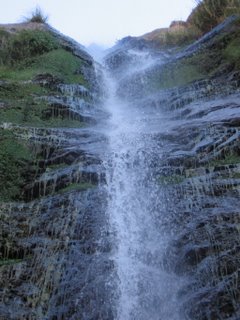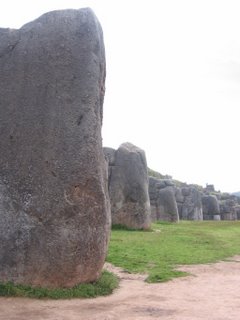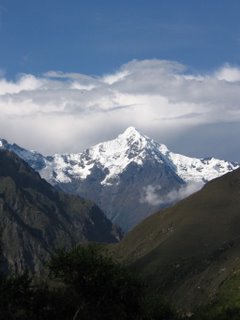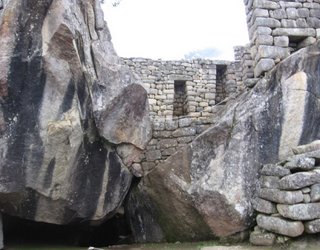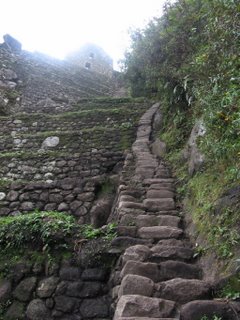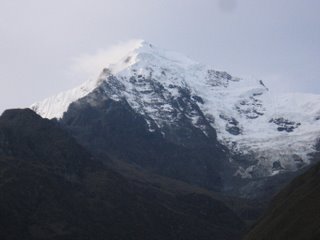Buenas Dias from Santiago
After a pretty good flight from Sydney (the sleeping tablets worked like a bomb), we arrived in Santiago. Tereza “I whipped out the Latin American dictionary and tried to master Spanish within a couple of minutes so I could at least try and get a taxi driver to take us to Vitacura. I was chuffed, I used my Portuguese and a couple of Spanish words and off we went. Of course I get to the taxi and the guy has now changed the price (a lot more than was previously quoted).” We arrived at Michael, Nina and Simon’s place, to confirm that the taxi driver was indeed trying to rip us off. With a few choice words in Spanish from Nina we got part of our money back.
Santiago doesn’t have much going for it except the booming economy and, if you can see it through the haze, the Andes in the distance. It’s a big sprawling city of smog and pollution that is growing at a rapid rate with buildings being constructed and highways popping up all over the place which is great for Richard Davies formwork business.
Ricky “I think you can judge people by the way they treat animals, particularly dogs, because kindness towards them is a selfless act and cruelty, malicious and selfish. It says a great deal that there were miserable stray dogs all over Chile. In contrast, every second person in Rio had a cute pampered little pooch in great condition.”
We stayed with Michael, Nina and Simon in their new house in Vitacura, an upmarket residential suburb of Santiago. It was great to catch up with the Davies’ household and to see how Simon is growing up. For the next couple of days we suffered from jetlag – sleeping in the afternoons and wide awake at midnight.
Having been to Santiago previously for Michael’s wedding, we didn’t do the touristy things in town, but instead opted (on Michael’s good advice), to head to San Alfonso which is at the foothills of the Andes. English in Chile seems to be unheard of, so it was out with the dictionary again. We managed to find our way from Puento Alto to San Alfonso on the local bus service which was almost for free! We stayed in a beautiful place called Cascadas de Animas, which definitely wasn’t for free. To make up for the cost of the place we used our cabin’s little kitchen to whip up our meals instead of going to the restaurant. Cascada de Animas is set at the foothills of the Andes alongside the River Maipo, with a wooden restaurant overlooking the river - Great looming sun-backed grey granite mountains, a huge oval swimming pool (too cold for Tereza to swim in) and cool green trees and shrubs. Ricky “The poplar and gum trees were reminiscent of our family’s farm in the Free State”.
On our arrival, we made the most of the place by hiking (trekking for the New Zealanders) to the nearby cascada responsible for the name of the place. Although the trail was hard going, with steep assents up dusty grey shale slopes, there was a stark beauty to the dramatic pallid lunar landscape with its resilient cactus sentinels. Tereza “I thought I was in the Wild, Wild, West!” The lush green ferns and lichen growing behind the 20 meter high waterfall was a pleasant contrast.
The next day we set out on a 4.5 hr walk in preparation for the Machupicchu trial we planned to do in Peru. We went with Oriana, who is one of ten children (now adults) that live with their parents in Cascade de Animas! The property has been owned by the family for 200 years. To our great surprise and curiosity she asked us whether we would mind if she brought her puma (yip a puma) called Willow, along for the walk. Tereza: “I was scared, particularly since she told us Willow means “scratch” and Oriana’s legs looked as if they’d been used as Willow’s scratching pole, but Ricky was pretty cool about it.” Oriana is hand-rearing Willow, who was abandoned by her mother. She told us that wild Pumas are virtually extinct in Chile. Willow was beautiful. She played, chased and teased Oriana’s three the dogs that also came along for the walk. What a site to see, Oriana, three dogs, Dan and Natasha (a Russian couple living in Dallas that joined us) and the two of us strolling along with a puma. Unlike her dog counterparts, Willow did not walk or follow us, she did her own thing. At one point he decided to lie down between Ricky’s legs! However, most of the time he would go roaming and Oriana had to continuously call out to him so he would not get lost or go and chomp a goat or dog from the neighbouring farms or houses – charming!
The hike was again difficult, slippery, dry, shale. Tereza: “Sliding down on my bum was the norm, and grabbing big sturdy branches of trees was a way of avoiding too much damage!” But there were rewards - beautiful sun-leached greens, browns and oranges, cacti with bright flowers, orchards of fruit (including grapes, youngberries, walnuts) and a translucent stream. Best of all was view of the more lush valley below filled with eucalyptus and poplar trees suffused in the light of the setting sun and intersected by the wide rushing pale blue green ribbon of the River Maipo.
At one point we were greeted by bright blue, pink, yellow and green coloured “dream catchers” hanging from the branches of a tree. They were hung up by locals to keep away evil spirits and pay homage to their Mother Earth, Pacchamamma.
The next morning we ventured a little further into the Andes to the town of San Gabriel. On the way we passed broken-down houses that reminded us of the film Motorcycle Diaries. Then, it was back to Vitacura where Michael had arranged a braai for a couple of friends (Tony and Tim who we met at Michael and Nina’s wedding) and his neighbours. It was great catching up and reminiscing about Michael and Nina’s buddymoon of Jan 2002 where we spent a week together at Pucon in southern Chile.
As Michael was busy and Nina expecting, Heather (Michael’s mum) generously volunteered her services as a tour guide. She was a wonderful tour leader – first of all she speaks Spanish fluently (except when getting out of speeding fines) and apparently enjoys showing everyone around the town! She took us to Yerba Loca (Sanctuary of Nature) in the Andes about 45 mins from Santiago. The weather was beautiful and sunny with a chill in the air. Stark grey-blue mountains, pale green shrubbery here and there, glacial turquoise rivers transforming into rapids and little waterfalls and an awesome view of a glacier called La Paloma or El Altar (not quite sure which one). We walked around for about 3 hours and discovered cacti with bright red flowers, eagles, horses, cows and more. Just as we were rounding up a wonderful excursion, Murphy struck – Heather caught her boot on a long strand of barbed wire from an old fence that was slyly concealed under a conspiring bush. There was an initial tug to which Heather responded with a determined countervailing pull, this was followed by a sort of a hop, skip and lunge as the prehensile wire refused to relent and Heather bit the dust. For a moment we were all caught in the shock of it, as a cloud of dust enveloped Heather. Fortunately, the dusty path proved to be a cushion of sorts and Heather proved to be made of sturdy material. To add to our shock, Heather then stripped down and gave her bludgeoned knees a freezing bath in a nearby glacial stream. To settle our nerves, we all headed for a much needed Cerveza (beer) at a nearby winter ski resort, Farellones. After the Cerveza had done its work, undaunted by her ordeal, Heather repeated a prior offer to take us to see the Chilean poet Pablo Neruda’s renowned house in Isla Negra.
The next morning, we caught a bus to Providencia, a suburb with tree lined streets and beautiful old delicate buildings, to meet Heather. In general Isla Negra consists of little shantytown houses bisected by dirty streets infested with the previously mentioned stray dogs. Pablo Neruda’s house was one of the slightly more affluent houses overlooking to the sea.
In short, Pablo Neruda was a leftist poet. As a result, he is not very popular with most conservative rightwing Chileans. His poetry was very modern for his time. He, loved women, wrote about love and nature, particularly the sea. Translations of his poetry are very moving and he was undoubtedly a master word-smith, notwithstanding his more controversial involvement in politics. In 1971 he won the Nobel Prize for Literature. He died of cancer in 1973.
Tereza: “Upon arriving at Pablo’s house, I was reminded of my grandfather’s house in Madeira, particularly because it was infused with the smell of log fires.” The day was pretty miserable but the tour guide was really good. The house was next to a beach with a view of the sea. From the windows of the lounge you could see a small dilapidated brick house building which served as Pablo’s studio for many years. The entire house was a collector’s treasure trove filled with eclectic selections of artefacts, baubles, and oddities. The lounge had a number of huge wooden figureheads from yesteryears ships adorning it, bright glass piano leg stands, a big ship’s wheel in one corner, a telescope and navigation equipment and more. There were shells on the ground leading from lounge to dining room to massage feet. Although Pablo was a tall man, the doors to his house were very narrow and low! The house and his studio were filled with collections of butterflies, insects, devils, masks from China to Africa, maps of the world, carved wooden door pieces, bottles with ships in them, a wooden virgin Mary replicas from the Easter Islands, a life-size horse, paintings, bright coloured tapestries made in Isla Negra, mosaics, ship placemats and bright coloured jars of brown and orange on the sill of the window looking landwards and blue and green jars on the sill of the window facing out to sea. He loved coloured glass and said that wine tasted better if it was drunk out of a coloured glass. An undying romantic, his and his wife’s initials were carved on the cupboards in their bedroom. Tereza: “This was one of the most interesting places I have ever been too!”
Next on the itinerary was Pomaire famous for its ceramics. As it was past lunch time, we decided to try out some local dishes. A soup with chicken, rice, potato and mielie, an empanada with chicken and a chicken pie with a crust made of mielies with sugar – while wholesome, all the dishes were bland and unexciting. Tereza: “I wasn’t feeling well, having caught a cold from Nina and Michael and so I tried to fortify myself with a drink called Viana (similar to Baillie’s) which did the trick until I collapsed towards evening.”
Pomaire consists of many streets all crowded with shops offering the same pottery: dark brown in most cases with bright coloured ceramic pigs, necklaces and masks. The pottery was incredibly cheep but we didn’t have porters to follow us around the world.
Heather, thanks sooooo much for showing us around, you were an excellent tour guide and great company!
To ensure we didn’t impose too great a burden on Michael and Nina, we took another excursion to Vina del Mar and Valparisso (the beaches of Santiago – 100kms away). We climbed on a bus to Vina del Mar and found an inexpensive hostel in an old house. Vina del Mar’s waterfront consists of hotels, casino and swanky restaurants, the rest is more rustic. We discovered a little deli with great cake! There were numerous horse drawn carriages to go riding in. There were plenty of bars, clubs around the area we stayed in, even one called Legolas but Tereza was too sick for us to go out on the town.
The next day, after croissants and coffee, it was off to Valparisso to find another of Pablo Neruda’s multiple houses. Pablo Neruda explains Valparisso: “Hills of Valparisso decided to dislodge their inhabitants to let go of the houses on top to let them dangle from cliffs that are red with clay, yellow with gold thimble flowers, fleeting green with wild vegetation. But houses and people clung to the heights writhing, digging in, worrying, their hearts set on staying there, hanging there tooth and nail to each cliff.”
Despite the dramatic description, the hills surrounding Valparisso are not as steep as Clifton. It has lots of small streets, with lots of broken down places, winding streets where buses race along if on a Grand Prix circuit, friendly bus drivers who don’t speak a word of English, unsafe areas and poor people. After four busses, we managed to pop in to see Pablo’s house high above Valparisso – bright coloured walls of blue, green, pink and yellow. While as not as interesting as the one at Isla Negra it offered beautiful views over the port - a mosaic of derelict houses on the one side and more upmarket houses on the other. Valparisso a city of contrasts!
Ricky: “Having read the swashbuckling adventures of Lord Cochrane a famous British naval officer who not only fought the French but helped Brazil and Chile gain independence, it was great to see that he is revered in Valparisso with monuments and museums dedicated to him. Everyone should read Lord Cochrane’s adventures, they include special force operations against daunting odds, fantastic naval feats, great bravado and daring, internal naval political battles, a stock exchange fraud involving a false report of Napoleon’s death and jail breaks.”
After Valparisso, it was back to Santiago and for the first time we could see the beautiful Andes’ ice-capped mountains surrounding the city!
Michael, Nina and Simon thanks for your hospitality, Simon we enjoyed your bubbliness, story books and Spanish lessons. Michael and Nina congratulations again on the birth of Ian! (He arrived just after we left.)
Photos of Cascadas de Animas - Santiago
